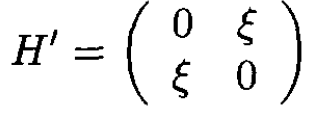
Stark Effect in Hydrogen
 المؤلف:
Sidney B. Cahn, Gerald D. Mahan And Boris E. Nadgorny
المؤلف:
Sidney B. Cahn, Gerald D. Mahan And Boris E. Nadgorny
 المصدر:
A GUIDE TO PHYSICS PROBLEMS
المصدر:
A GUIDE TO PHYSICS PROBLEMS
 الجزء والصفحة:
part 2 , p 69
الجزء والصفحة:
part 2 , p 69
 22-8-2016
22-8-2016
 1862
1862
Stark Effect in Hydrogen
Consider a single electron in the n = 2 state of the hydrogen atom. We ignore relativistic corrections, so the 2s and 2p states are initially degenerate. Then we impose a small static electric field E = |E|ẑ. Use perturbation theory to derive how the n = 2 energy levels are changed to lowest order in powers of |E|.
SOLUTION
We use the notation |LM⟩ to describe the four orbital states: the s-state is |00⟩ and the three p-orbitals are |1 – 1⟩, |10⟩, |11⟩. Spin is not affected by this perturbation and plays no role in the calculation. For degenerate perturbation theory we must evaluate the 10 different matrix elements ⟨LM|V(z)|L'M'⟩ which occur in the symmetric 4 × 4 matrix. The interaction potential is V = -e|E|z. One can use parity and other group theory arguments to show that only one matrix element is nonzero, and we call it ξ:
 (1)
(1)
Since the two states | 1 ± 1⟩ have no matrix elements with the other two states, we can omit them from the remaining steps in the calculation. Thus we must find the eigenvalues of a 2 × 2 matrix for the states |00⟩ and |10⟩.
 (2)
(2)
This matrix has eigenvalues λ = ±ξ. The perturbation splits the fourfold degenerate n = 2 state into states with eigenvalues
 (3)
(3)
Since is proportional to the electric field, the energies split linearly with |E|.
The matrix element ξ can be evaluated by using the explicit representation for the n = 2 eigenstates of the hydrogen atom:
 (4)
(4)
 (5)
(5)
yielding
 (6)
(6)
The angular integral gives 2/3, and s = r/a0.
 الاكثر قراءة في مواضيع اخرى
الاكثر قراءة في مواضيع اخرى
 اخر الاخبار
اخر الاخبار
اخبار العتبة العباسية المقدسة


